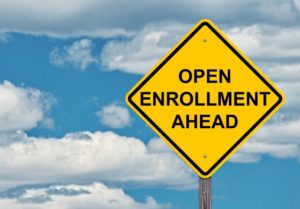 We are on the cusp of open enrollment season, the time of year when many employees have the opportunity to choose or change benefits — health, life, vision and dental, to name a few. But the complexity and stressors around open enrollment often mean that employees simply re-enroll in their previous year’s plan, rather than taking the time to consider their options and make an informed decision. More often than not, employees defer to the status quo, perceiving it as safer and easier than trying to navigate changes in cost, benefits terms, and more.
We are on the cusp of open enrollment season, the time of year when many employees have the opportunity to choose or change benefits — health, life, vision and dental, to name a few. But the complexity and stressors around open enrollment often mean that employees simply re-enroll in their previous year’s plan, rather than taking the time to consider their options and make an informed decision. More often than not, employees defer to the status quo, perceiving it as safer and easier than trying to navigate changes in cost, benefits terms, and more.
The fact of the matter is plans change. Life changes. And life circumstances shift often. There may be new benefits that were not previously available, or benefits that employees may want to add for one reason or another. This is why it is critical for employers—helmed by HR leaders—to serve as a trusted and transparent resource and champion for employees during open enrollment. With nearly a quarter of employees reporting feeling unprepared for open enrollment, and almost half spending less than an hour researching health benefits during open enrollment, there is a clear and present need for employers to deliver counsel and guidance. Afterall, employee benefits are one of the most important ways you can attract and retain a talented and committed workforce; you should do everything in your power to find ways to balance the costs and complexities of benefits administration. Doing so will ensure you’re prepared for the evolving world of work and help you win the war on talent.
PREMIUM CONTENT: Internal staff ideas on how to improve your staffing firm
Here are the top five things every employer should be doing during open enrollment to address common pain points and deliver value to employees.
- Remind employees of changes in policy. With open enrollment periods that are short, it’s important for employers to send friendly reminders to their employees. Consider spacing communication starting with an initial reminder email one week prior to open enrollment, another when open enrollment begins, one halfway through the period and a final email one week/one day before it closes. This schedule will be particularly helpful to longer-tenured employees who may be accustomed to the 90-day periods of years past. And don’t forget your remote employees and employees on a leave of absence.
- Simplify! Simply! Simplify! Streamline the process as much as possible. Instead of leaving employees to their own devices, opt to consolidate all plan information in one place that is easily accessible. This will empower them to better understand their options at a glance. Consider the preferences of your multidimensional workforce and communicate appropriately. Syndicate materials across digital and physical mediums—brochures, emails, short videos, mobile dashboard, etc.—as diverse workforces may have varied preferences when it comes to content consumption.
- Get ahead of questions. Anticipating your employees’ needs goes a long way in establishing yourself as an advocate and educator. Consider creating a robust FAQ that gives employees, their managers and your HR business partners valuable resources at their fingertips. Not only will they appreciate the gesture, but it could translate to more efficient communications for you too.
- Open-door policy. Ensure all communication lines are open and that your team is available for questions. Establish “office hours” at varying points during the open enrollment period to give employees another touchpoint for engagement. Establish change champions locally.
- Welcome post-mortem meetings. Huddle with your team post-enrollment to see what worked, what didn’t work and how the company can make the process more efficient next year. Consider disseminating a survey to your employees asking for their feedback, as well. You should compare survey results against the current suite of solutions you’re using to manage benefits administration. If findings suggest your employees are dissatisfied, it may be time to reevaluate the tools and technology you’re using across your employees’ benefits journey. Regardless, you’ll want a solution that enables you to streamline benefits administration.
At the end of the day, there is no reason open enrollment should be a source of stress for employers or employees. When communications happen early and often, everyone can feel educated and empowered to tackle open enrollment with the confidence of knowing they’re selecting the best benefits for their life right now. Take the initiative to start a dialogue sooner than later, and follow these recommendations to execute an open enrollment plan in a productive and goal-oriented manner.








